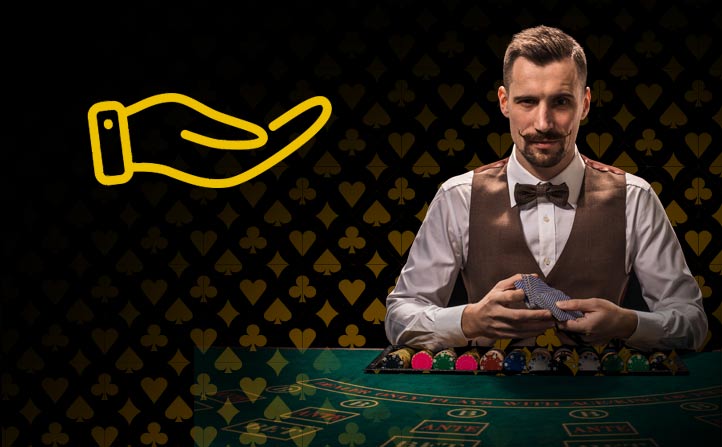 Loved worldwide, blackjack continues to endure among the most popular casino games. Blackjack games may look straightforward, but there is quite a bit of strategy in this casino game. This article will dive into the ins and outs of hitting and standing, including when to stand or hit in blackjack and why.
Loved worldwide, blackjack continues to endure among the most popular casino games. Blackjack games may look straightforward, but there is quite a bit of strategy in this casino game. This article will dive into the ins and outs of hitting and standing, including when to stand or hit in blackjack and why.
What do hit and stand mean in an online blackjack game?
The main objective when playing blackjack is to get as close to 21 as possible without busting, and getting closer to 21 than the dealer. The game begins when the dealer hands out the first two cards. This is where a player may choose to hit or stand in blackjack.
If the cards dealt are good, the player may choose to stand, meaning they play their hand as it is. If the cards are bad, the player may hit, meaning they draw an additional card, hoping to better their hand.
Hitting can swing the odds in the player’s favour, even quite significantly. However, hitting risks your hand going bust, and standing risks the dealer’s hand trumping yours.
Should I hit or stand?
So when should you hit or stand in blackjack? There are a few factors to take into consideration.
Deciding the fate of your hand isn’t only about your hand total. The dealer’s upcard also has a part to play, as well as whether the dealer stands on a soft 17. Knowing when to hit or stand is an art; sometimes, the most obvious choice isn’t always the right one. There’s risk in everything when playing blackjack. Practice can help you sharpen your skill.
Blackjack: when to hit
While there are many different strategies you can adopt, the basic strategy is the most widely used. The basic blackjack strategy is a numbers game rooted in probability theory. With a hand value of eight, for example, hitting is a good strategy move because the chances of earning a better-valued hand are favourable.
Let’s take a look at the hitting strategy on soft and hard hands:
Hard Hands
- On four to eight
Always hit, regardless of the dealer’s card.
- On nine
Hit if the dealer shows two or seven through ace.
- On 10
Double down if allowed when the dealer offers two through nine. Otherwise hit.
- On 11
Double down if allowed when the dealer shows two through ten, and hit on an ace.
- On 12
Hit on two, three and seven through ace. Stand on four through six.
- On 13 and 14
Stand on two through six, otherwise hit.
- On 15
Stand on two through six, hit on seven, eight, nine and ace. Surrender on 10 (if allowed); otherwise, hit.
- On 16
Stand on two through six, hit on seven and eight. Surrender on nine, 10 and ace (if allowed); otherwise, hit.
- On 17+
Always stand.
Soft Hands
- On 13 and 14
Hit on two through four and seven through ace. Double down on five and six if allowed. Otherwise hit.
- On 15 and 16
Hit on two, three and seven through ace. Double down on four, five and six if allowed. Otherwise hit.
- On 17
Hit on two and seven through ace. Double down, if possible, on three through six; otherwise, hit.
- On 18
Stand on two, seven and eight. Hit on nine through ace. Double down on three through six, if allowed; otherwise, stand.
- On 19+
Always stand.
When Not To Hit In Blackjack
The closer a hand total is to 21, the less it is recommended to hit. This is because the likelihood of busting is more significant.
When to double down or split in blackjack
Doubling down means doubling your bet before the dealer gives you another card. Splitting involves dividing a hand in two when dealt two identical cards, matching the original bet with a second wager of the same value.
Doubling down is viable when your hand totals 10 or 11. There is a 30.7% chance of hitting another 10-value card, thus forming a high-value hand. Splitting must be communicated immediately.
Splitting a pair of aces works because there are more 10-value cards in the deck. When splitting aces, the likelihood of hitting 21 with an ace is much higher. Hitting, standing or splitting pairs depends on the table you’re playing on.
Quick Tips:
- Double down if the dealer has two through six and you have nine.
- Double down if the dealer’s face-up card is two through nine, and you have a 10.
Blackjack: When to stand
Hitting and standing are two sides of the same coin. They are opposites but depend on the same variable: who is better off once the numbers have been crunched?
Quick Tips:
- Stand if you have 17-21.
- Stand if the dealer shows a two through six and you have 13-16.
- Stand if the dealer has four, five or six, and you have a 12.
The basic blackjack strategy chart
Here’s a basic blackjack strategy chart to help you better visualise the information.
| Dealer’s up card | 2 | 3 | 4 | 5 | 6 | 7 | 8 | 9 | 10 | A |
| Player’s hand | ||||||||||
| 8 | H | H | H | H | H | H | H | H | H | H |
| 9 | H | DD | DD | DD | DD | H | H | H | H | H |
| 10 | DD | DD | DD | DD | DD | DD | DD | DD | H | H |
| 12 | H | H | S | S | S | H | H | H | H | H |
| 13 | S | S | S | S | S | H | H | H | H | H |
| 14 | S | S | S | S | S | H | H | H | H | H |
| 15 | S | S | S | S | S | H | H | H | H | H |
| 16 | S | S | S | S | S | H | H | H | H | H |
| 17 | S | S | S | S | S | S | S | S | S | S |
| A-7 | S | S | S | S | S | S | S | S | S | S |
| A-8 | S | S | S | S | S | S | S | S | S | S |
| A-9 | S | S | S | S | S | S | S | S | S | S |
| KEY | H=Hit | S=Stand | DD=Double Down |
What To Do When You Have a 14, 15 or 16-Card Hand?
If your hand totals to 16, the safest choice is to stand if the dealer shows anything from a two to a six. If the dealer reveals a high-value card, like face cards, it is recommended to hit before the dealer shows blackjack.
Hit and stand in different blackjack variants
Blackjack rules have a simple format once you get the hang of them. However, different variations of blackjack tweak them accordingly. This alters the player’s hit-and-stand betting system.
For example, Atlantic City Blackjack features a late surrender option. As the name implies, the player gives up their hand after the dealer checks their hand. It also means that 50% of the bet is returned, cutting losses in the event of a difficult hand.
On top of that, European Blackjack may also include side bets that impact a player’s strategy to a degree.
Conclusion – Basic blackjack rules for hitting and standing
Hitting or standing makes blackjack what it is. If you want to play with the big leagues, knowing when to hit or stand is the foundation for your strategy. You can gain confidence through practice, strategy charts and careful observation.
While you can’t guarantee a win with a soft hand, it does help to maximise your potential and impact the house edge if only for one round. Keep an open mind, though — it depends on the given table!
FAQ
✅ Where can I play blackjack online?
Blackjack can be played anywhere, whether in a land-based casino or online. Most casinos also have different variations and tables to cater to a wider variety of blackjack players. At LV BET, you can find tables with more decks, various side bets and detailed explainers on playing, as well as many other online casino games!
✅ What is the minimum bet at a blackjack table?
There is no one specific minimum bet for all blackjack tables. It can vary between tables.
✅ Should you use a strategy chart?
Basic blackjack strategy can help you work out when it is best to hit or stand, and a hit or stand chart is an excellent way to learn when playing blackjack hands that are new to you.
✅ What is the value of an ace in blackjack?
The ace is either a one or 11, depending on the state of your hand. Aces make for a soft hand.
